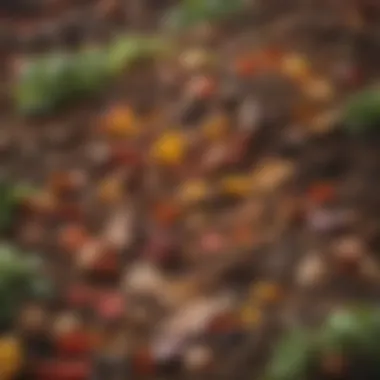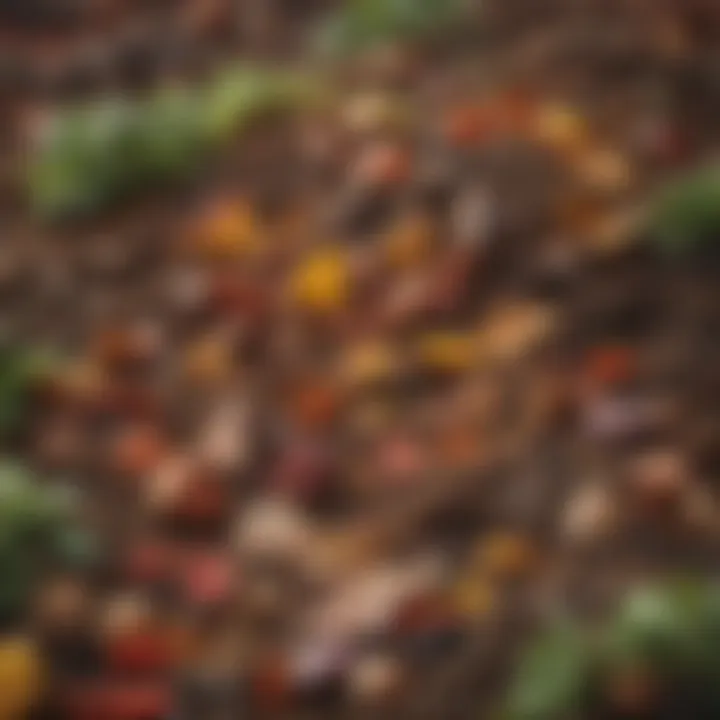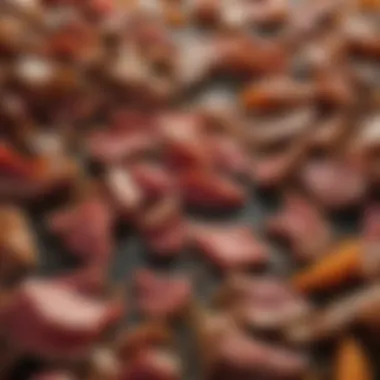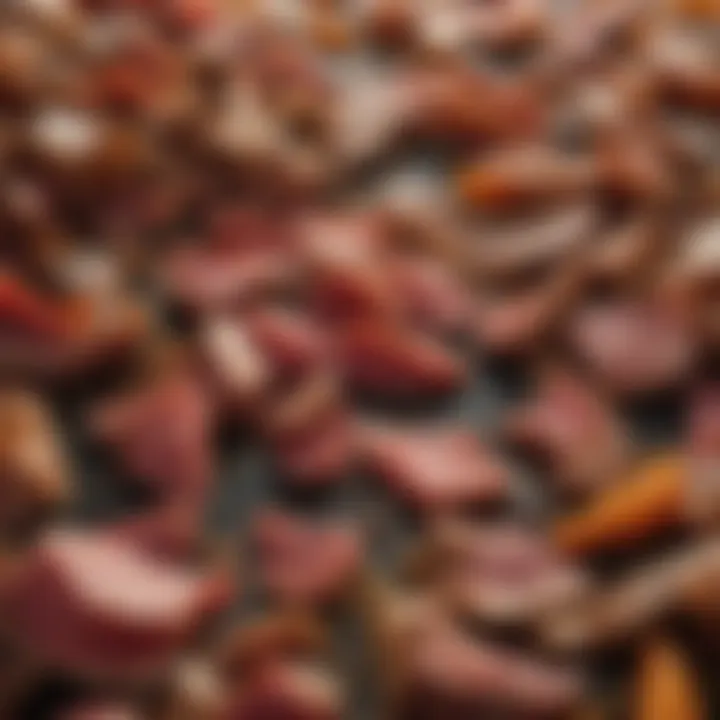Can You Compost Meat Scraps? A Comprehensive Exploration


Intro
Composting is a powerful practice in maintaining ecological balance. Many individuals engage in this process to turn organic waste into nutrient-rich soil for gardens or potted plants. However, the question of whether to include meat scraps in compost remains a topic of debate.
Meat scraps are rich in nitrogen and can contribute to a healthier compost mix. Yet, they also attract pests and could become a source of unpleasant odors if not handled properly. Therefore, understanding both the benefits and challenges of composting meat scraps is essential for effective waste management and environmental sustainability.
In this exploration, we will walk through critical aspects of composting meat scraps, from guidelines and techniques to the ecological implications. By providing a thorough understanding of this subject, individuals will be better equipped to make informed choices regarding their composting endeavors.
Understanding Composting
Composting serves as a critical practice in managing organic waste effectively. As concerns over waste generation and environmental impact grow, understanding composting becomes crucial for both individuals and communities. Recognizing the process of composting offers significant insights into how nutrients recycle back into the soil. Furthermore, it not only reduces landfill overflow but also fosters healthier ecosystems.
Composting transforms waste materials into valuable resources. For home gardeners and professionals alike, this conversion yields nutrient-rich compost that enriches soil. When considering composting meat scraps specifically, it leads us to discuss essential concepts underlying effective composting.
What is Composting?
Composting is the natural process of recycling organic matter, like food scraps and yard waste, into a usable soil amendment. Generally, the process consists of managing microorganisms that break down these materials in a controlled environment. Decomposing organic matter leads to the formation of compost over time, which serves various purposes in agriculture and gardening.
- Nutrients Availability: Within compost, nutrients are made accessible, significantly increasing soil fertility.
- Environmental Benefits: Composting reduces the need for chemical fertilizers, improving overall soil health without damaging ecosystems.
- Waste Reduction: It uniquely contributes to diverting significant volumes of organic waste from landfills.
In addition to the above points, composting can potentially influence local environmental policies, advocating for participation in sustainable practices.
The Role of Microorganisms in Composting
Microorganisms play an indispensable role in the composting process. Various bacteria, fungi, and other microbes are responsible for breaking down organic materials. These tiny organisms function by consuming carbon and nitrogen-rich substances, resulting in decomposed, nutrient-dense compost.
Key takeaways about microorganisms in composting include:
- Temperature Regulation: As these organisms operate, they generate heat, creating a preferred temperature range for optimal composting.
- Aeration Necessity: Their activity necessitates adequate aeration due to aerobic respiration. Keeping the pile well-aerated supports longer-lasting microbial function.
- Diversity Matters: A mix of microbial species influences the complexity, leading to a richer compost.
Understanding these dynamics can enhance one's ability to maximize composting processes, especially when tackling the unique challenges associated with composting meat scraps.
The Types of Compostable Materials
Understanding the types of compostable materials is crucial for successful composting, especially when considering unconventional items like meat scraps. Composting relies on a balanced combination of materials to create an optimal environment for decomposition. In this section, we will explore green materials, brown materials, and specifically analyze meat scraps as a compostable material.
Green Materials
Green materials are rich in nitrogen and include components such as fruit and vegetable scraps, coffee grounds, and grass clippings. They are essential in any compost pile as they provide the necessary nutrients that aid in the decomposition process. The decomposition of these materials generates heat, which is vital for activating microorganisms in the compost. Notably, this heat accelerates the breakdown of both green and brown materials.
When adding green materials to your compost, aim for roughly a 50% ratio with brown materials. Examples of green materials include:
- Vegetable peels
- Fresh plant trimmings
- Green manure
- Coffee grounds
The balance between green and brown materials ultimately determines the efficiency and effectiveness of there composting process.
Brown Materials
Brown materials are high in carbon and play a critical role in balancing the nitrogen levels introduced by green materials. They include items like dried leaves, straw, shredded paper, and cardboard. These materials not only provide structural support to the compost pile but also assist in moisture retention.
The ideal browns should be dry and crumpled to maximize aeration within the pile, which supports the oxygen-breathing decomposers. Incorporating brown materials slows down the rate of moisture loss, ensuring the microorganisms remain active. Careful rationing between raw materials is key in promoting an efficient medial for full decomposition. Consider including the following when embodying the brown component of desired compost:


- Shredded leaves
- Sawn wood or sawdust (untreated)
- Cartoons or newspaper (non-glossy)
These ingredients contribute heavily to the nutritional profile of the compost you are creating.
Understanding Meat Scraps as a Compostable Material
Meat scraps present a controversial yet fascinating element within the composting landscape. They are high in protein and can significantly enhance the nutrient profile of the finished compost. However, adding meat to compost comes with unique challenges. Foremost, their breakdown generates strong odors that may attract pests, including rodents—this factor greatly complicates the composting process.
In terms of nutrient load, meat scraps have higher nitrogen content compared to other green materials. Despite their potential contributions to enrichment, special care must be taken.
- Slicing Properly: Chop meat scraps into smaller pieces. This promotes better decomposition without overwhelming the compost balance.
- Temperature Control: The compost pile must reach high temperatures to safely break down meat, typically above 140°F for certain periods to reduce pathogen risks.
- Pest Management: Encasing the meat within layers of brown materials can help mask odors, which reduces the likelihood of pest infiltration. Additionally, burying the materials deep in the compost can offer them better coverage.
Ultimately, understanding the balance and interplay between green materials, brown materials, and meat scraps can empower anyone passionate about gardening or sustainability, leading to informed decisions in their composting practices.
The Benefits of Composting Meat Scraps
Composting meat scraps can seem counterintuitive at first. However, a deeper exploration reveals significant benefits that are too valuable to overlook. Understanding these benefits helps to motivate composters toward implementing best practices that will enable them to recycle meat scraps effectively. This section discusses two essential benefits: the production of nutrient-rich compost and the positive environmental impact achieved through waste reduction.
Nutrient-Rich Compost
Composting meat scraps contributes to the creation of nutrient-dense compost that bolsters soil health. Meat scraps, while often limited to scenarios involving confident composters, can supply essential nutrients such as nitrogen, phosphorus, and potassium. When these scraps are broken down effectively, a significant bonus arises: vibrant compost which can enhance plant growth.
By combining both meat and plant materials, it generates a more varied compost mix. This balance allows the nutrients to become available more comprehensively than if they were composed solely of plant matter. Thus, incorporating meat helps enrich the soil, moving it beyond the basic nutrient profile provided by traditional plant material. The composting process converts meat into organic matter that boosts soil aeration and water-holding ability, critical factors for the health of plants.
If done correctly, the compost will also contain a more complex microbial community. This diversity not only benefits compost-breakdown speed but also introduces stability to the soil environment, encouraging healthier plants.
Nutrient-rich compost is a vital factor in promoting robust plant growth. It is worth weighing the potential rewards against the challenges.
Waste Reduction
In today’s society, food waste presents a significant problem. Composting meat scraps offers an opportunity for effective waste reduction. When people discard meat, it often ends up in landfills, where it generates methane gas during decomposition. This gas can contribute dramatically to climate change due to its potent greenhouse properties.
By composting meat leftovers rather than throwing them away, we can divert them from landfills. This action contributes to a more sustainable waste management approach. Furthermore, society benefits by reclaiming valuable resources, reducing reliance on commercial fertilizers, and supporting a more circular economy.
In addition, this practice fosters awareness about our food waste habits. By tackling our dinner scraps directly, chefs and home cooks learn to be creative with all parts of their ingredients. Getting accustomed to composting increases our awareness surrounding food use and reaffirms the resolve towards sustainable living.
Overall, the ability to compost meat scraps serves as a crucial step in reducing our ecological footprint while simultaneously contributing essential nutrients back into the earth. The conversation around composting involves understanding these benefits clearly amidst the challenges, paving the way for informed and practical composting practices.
The Challenges of Composting Meat Scraps
Composting meat scraps captures a plethora of nuances that anyone considering this practice should be aware of. While it comes with certain advantages, the execution is not without its challenges. Often, these challenges discourage individuals from incorporating meat into their compost bins. Adhering to best practices means understanding these obstacles, allowing for informed decisions that align with both ecological benefits and the consumer's comfort level with handling food waste. Here is a detailed look into the key challenges:
Odor Issues
One of the most common difficulties in composting meat scraps is odor management. Meat, when decomposed, produces significant odors which can resonate unpleasently. Chemical processes occurring due to anaerobic decomposition create a characteristic foul smell that not only attracts attention but can also raise concerns within your household or environment. Effective management strategies such as covering meat scraps with carbon-rich materials, like dried leaves or wood chips, can mitigate odor. Regular aeration of compost piles also assists in reducing these smells. The approach involves both maintaining careful oversight over the level of meat added and promoting adequate air flow.
Pest Attraction
Additionally, the inclusion of meat scraps can lead to unwanted pests. Rodents, flies, and other scavengers are attracted to decomposing meat due to the smells it emits, posing a challenge to both sanitation and peace of mind. Preventing pest attraction is crucial for an effective composting practice. Strategies might include using enclosed compost bins, only adding meat in controlled quantities, and burying scraps under ample layers of brow materials. Thus, comprehensive lid or wall solutions could be useful, as open exposure to weather and wildlife can become a significant concern due to pest interference.
Pathogen Concerns


Finally, composting meat raises significant pathogen concerns. Raw meats can harbor bacteria such as Salmonella and E. coli. If not exposed to the appropriate temperatures during composting, there is a potential risk for pathogens to survive. High temperatures in composting piles, often referred to as the 'hot composting' method, can effectively kill harmful bacteria. To ensure compost is safe for use, monitoring the internal temperature of the bin becomes necessary, typically aiming for at least 145°F (63°C). Regular turnings aid significantly in maintaining temperature and reducing risks.
Culmination
Being aware of these distinct challanges promotes a deeper understanding of composting meat scraps. Recognizing odor issues, handling pest attraction, and addressing pathogen concerns guide participants in selecting appropriate methods which honor hygienic practices and environmental benefits. Careful management leads the way in framing composting meat’s embrace within fruitful ecological systems.
“The struggle with correctly composting meat is not insurmountable; it guides us towards improved methods and greater problem-solving.”
Best Practices for Composting Meat Scraps
Composting meat scraps can yield valuable nutrients but requires careful management. Understanding best practices is essential for success. Sufficient knowledge helps in maintaining a balanced compost pile, enhancing benefits while minimizing challenges. This guide offers specific elements to consider for effective composting. Good awareness ensures the risks are managed and that composting becomes a viable project.
Choosing the Right Composting System
When it comes to composting meat scraps, not all systems are created equal. Choices range from traditional bins to specialized systems like in-vessel composters. Here are some key aspects to consider:
- Closed Systems: Hot composting typically requires enclosed systems to control temperature and break down scraps efficiently. This helps avoid attracting pests.
- Aerated Static Piles: This type of system also promotes higher temperatures, which helps in fast decomposition and odor control.
- Bokashi System: It involves fermentation, making it suitable for all food scraps, including meat.
Evaluating the environment and waste volume will significantly impact which system best caters to your composting needs. Understanding their strengths leads to better strategies and outputs.
Maintaining Aeration and Temperature
The significance of both aeration and temperature cannot be overstressed. Proper composting need a thermal environment conducive for microbial activity. Here’s how you can maintain these factors:
- Turning the Pile: Regularly turning the compost helps aerate the pile, introducing oxygen necessary for breakdown. Encourage higher temperatures for efficient decomposition.
- Temperature Monitoring: Maintaining decomposition that peaks between 130°F to 160°F (54°C to 71°C) is ideal. Use a compost thermometer for accuracy.
- Moisture Levels: The compost should feel damp but not soaked. Striking balance is critical as both too much and too little water during breakdown fosters undesirable conditions.
Paying to these aspects promotes a healthy pile. This helps eliminate odors and maintains the rate of decomposition.
Balancing Green and Brown Materials
A successful compost pile consists of a balanced amount of green and brown materials. Green represents nitrogen-rich components while brown deals with carbon. Here’s how to achieve the right ratio:
- Ideal Ratios: Aim for a mix of roughly 1 part green to 3 parts brown materials. Proper ratios ensure an efficient breakdown process.
- Types of Materials: Common greens include vegetable scraps and lawn clippings, while dried leaves, straw, and cardboard class as browns. Each category supports participation of necessary microorganisms aiding digestion.
- Incorporating Meat: Meat scraps fit as a green in the ratio because they travel long to decompose. Use small portions and keep meat mixed in well with browns to maintain the focus on carbon and avoid attracting pests.
Maintaining the balance carefully fosters a robust compost pile. Consequentially, a thriving mix also enhances the resulting compost’s quality.
"Understanding these best practices transforms composting from a simple task into a meticulous process that can yield incredible results."
Applying these points fosters better interactions with your composting setup. Through meticulous attention to detail in structure and materials, achieving rich compost is well within reach.
Alternatives to Composting Meat Scraps
The topic of alternatives to composting meat scraps is essential in understanding how to deal with this common kitchen waste effectively. Not everyone has the means or the willingness to compost meat properly, given its unique challenges. Therefore, exploring viable options becomes crucial for those who seek to minimize their ecological footprint without utilizing traditional compost methods. The following sections detail alternative techniques, highlighting their specific characteristics and benefits.
Variations of Composting Techniques
One alternative to traditional composting meat scraps is the use of variations in composting techniques, such as hot composting and bokashi composting. Hot composting involves maintaining a higher temperature in the compost pile to break down organic materials more rapidly, including meat, while minimizing odors and pest attraction. This method requires strict monitoring of temperature and a balanced mix of organic materials.
Bokashi composting is another interesting option. This method relies on fermentation, using special microorganisms to break down food waste, including meat, in a sealed container. After a few weeks, the fermented waste can be buried in soil or added to a traditional compost system, introducing beneficial bacteria to the mix. Each of these techniques has its advantages and can offer a solution where traditional composting may present challenges.
Using Meat Scraps for Animal Feed


Using meat scraps for animal feed is another alternative to direct composting. This approach can be beneficial where permissible by local regulations. It allows for the recycling of nutrients into the food chain while efficiently utilizing surplus kitchen waste. Livestock, such as chickens and pigs, can benefit from this kind of feed, providing a use for leftover proteins that might otherwise go to waste.
However, this method occurs with careful consideration and strict adherence to health guidelines. The meat scraps may need to be cooked or processed to eliminate harmful pathogens. Understanding local regulations concerning food safety is essential to facilitate this option positively.
Digestion Technology for Food Waste
Digestion technology refers to processes that again divert food scraps from landfills. Anaerobic digestion is a prime example. In this controlled environment, microorganisms break down organic matter like food scraps, producing methane that can be utilized for energy. Unlike traditional composting, anaerobic digestion provides an efficient means to convert meat scraps into energy while also creating a nutrient-rich digestate that can be incorporated into soils.
This technology presents an advanced solution to food waste, including meat. However, these systems may require significant upfront investment and may not yet be accessible for every household. Still, interest and innovation are growing, and local food waste management initiatives are increasingly adopting such technologies.
Exploring alternatives to composting meat scraps provides insights on sustainably managing food waste while addressing ecological concerns. Understanding the intricacies of each method can help individuals choose their best path forward and adapt to their unique circumstances.
The Ecological Impact of Composting
Composting is not just a method of recycling, but also a powerful tool for fostering ecological responsibility. Understanding its environmental advantages regarding meat scraps ensures a comprehensive grasp of composting's true potential. Waste, when improperly managed, contributes significantly to pollution and greenhouse gases. Composting creates a more sustainable pathway by redirecting these materials from landfills.
Carbon Footprint Reduction
Composting meat scraps offers a measurable impact on reducing your carbon footprint. When organic waste decomposes in anaerobic conditions found in landfills, it emits methane, a greenhouse gas much more potent than carbon dioxide.
By diverting meat scraps to a composting system, you facilitate aerobic decomposition, leading to minimal methane release:
- The bacteria in the compost pile thrive on oxygen, breaking down waste efficiently.
- Rather than creating harmful gases, composting captures carbon within the soil.
This transformation contributes to the mitigation of climate change, fostering a healthier environment. Adopting composting as a receptacle for organic waste highlights one's commitment to reducing waste and the associated carbon emissions.
"Every small action targeting waste and emissions can lead to large environmental gains. Every little effort nurtures our planet's longevity."
Soil Health Improvement
Improving soil health is another significant benefit of composting, including meat scraps. Organic matter is essential for nurturing soil biota. Meat scraps, when composted correctly, enrich the soil with crucial nutrients. The resultant compost operates as a fertilizer that can promote rich biodiversity in the soil. It benefits from extensive microbial activity:
- Enhances soil structure and aeration.
- Retains moisture, aiding plants during dry spells.
- Reduces soil erosion by establishing a better binding structure through natural components.
Moreover, using nutrient-rich compost helps minimize the need for chemical fertilizers. These synthetic alternatives can alter soil composition negatively and dịch vụ gây ô nhiễm.
The dual benefit of composting lies in reducing input costs for gardeners or farmers, while simultaneously improving the ecological balance of the soil.
This integrated approach—reduction of harmful emissions and enhancement of soil health—demonstrates not just the practicality of composting meat scraps but their necessity in our modern approach to environmental stewardship.
Future Considerations for Composting Meat Scraps
The topic of composting meat scraps undergoes continuous evolution as more methods and consumer perspectives emerge. Many people, including food lovers, cooks, and homemakers, view composting as a cornerstone of sustainable living and conscientious consumption. Addressing the broader issues surrounding the composting of meat scraps can lead to meaningful changes. Several elements are critical in shaping future efforts in this domain.
Emerging Composting Technologies
New technologies are making composting meat scraps more appealing and effective. Innovations such as aerobic digestion and in-vessel composting present efficient pathways to handle meat scraps without the associated problems of odor and pests. Aerobic digestion is a process that takes advantage of oxygen, promoting rapid decomposition and reducing harmful pathogens. Similarly, in-vessel composting farms the environment by allowing controlled conditions.
Technologies like these help to ensure safer and cleaner composting methods. Their streamlined processes can minimize environmental footprints, thus further reinforcing the idea of composting meat scraps as plausible and environmentally beneficial. By keeping abreast of upcoming technologies, consumers can make informed decisions that work for their lifestyles while encouraging sustainable practices.
Investing in understanding upcoming technologies is crucial for the sustainable future of meat composting.
Shifts in Consumer Awareness
As more information circulates about sustainability and food waste, consumer attitudes are shifting. A growing number of individuals crave information on how they can lessen their ecological footprints and improve local environments. There is a stronger awareness regarding the importance of composting and its role in creating nutrient-rich soil. With platforms for discussion and exchange of ideas, such as Reddit and social media, there is a rising demand for shared knowledge.
Such shifts in awareness are pivotal. They equip consumers with the understanding they need to venture into composting meat scraps responsibly. Increased awareness may also lead to community initiatives focusing on local organic waste management. Engaging with these communities can value-add to households and foster a sense of shared responsibility while lifting up gardening ambitions and sustainability goals.







